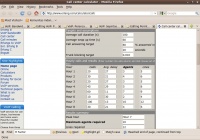VoIP Cookbook: Calculation for Call Center
Unlike a network serving small number of VoIP calls, a call center is often used to accommodate a high number of calls served by a given network, thus requiring a much more sophisticated calculation and planning tools. A Call Center can typically be a bank, travel agent, ticket reservation or even a mobile operator. So if you intend to establish a call center, please visit http://www.erlang.com/calculator/call/ to calculate how much bandwidth needed.
What we have to fill in as parameter are the length of calls (seconds), resolving time (seconds), percentage of calls answered within seconds, and percentage of calls that will be blocked. Blocked calls will receive busy tone, a sign indicating that all lines are busy. After all parameters are filled in, we need to enter the number of calls coming in an hour. Based on the values we entered, we will obtain simulation result showing how many agents and lines are needed to respond to the calls.
The next step is to estimate how much bandwidth is needed for a specific number of lines or a number of minutes, in a given percentage of calls that will be blocked and receiving busy tone. This is often measured using Erlang Traffic Model in terms of Erlangs, the unit representing usage of a voice channel. Erlangs Traffic Model measurement is very important to help you being a telecommunication network engineer to understand the traffic pattern and network topology necessary to determine the size of trunk group. In addition, the measurement can also be used to determine the number of lines needed between a telephone network or system and telephone center, or between network locations.
In practice Erlangs can be used to give an overall picture of traffic volume in an hour. For example, a user group makes 30 calls in an hour, and every call has an average talking duration of 5 minutes, then the Erlangs resulting from the traffic that takes place is:
| Traffic minutes in a given hour | = | Number of call x duration |
|---|---|---|
| Traffic minutes in a given hour | = | 30 x 5 |
| Traffic minutes in a given hour | = | 150 |
| Traffic hours in a given time | = | 150 / 60 |
| Traffic hours in a given time | = | 2.5 |
| Traffic size | = | 2.5 Erlangs |
The size of traffic is also called Busy Hour Traffic (BHT). The Busy Hour Factor parameter is a percentage of daily minutes of calls made during the most busy hour in a given day.
In addition to Erlangs, there is also blocking. Blocking represents unsuccessful calls because of insufficient number of lines. In other words, the caller will receive a busy tone from the center as all lines/trunks are being used. 0.01 blocking implies that 1% of calls made will be blocked. This decimal number is usually used in traffic telecommunication engineering. In a number of applications, blocking up to 0.03 (3%) is still tolerable. So this number should ideally be as small as possible.
It appears that the more we tolerate the number of blocked calls, the more minutes per day we will have. However, the more calls take place during peak hours or when busy hour factor increases, the less number of minutes per day we will have.
Now that you know what Erlang Traffic Model measurement is, you can plan your connectivity capacity for your call center, using a number of measurement tools available at http://www.voipcalculator.com/calculator/.
